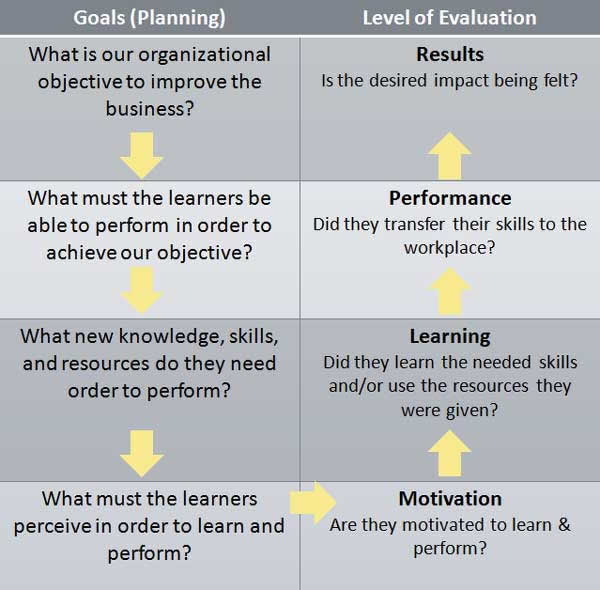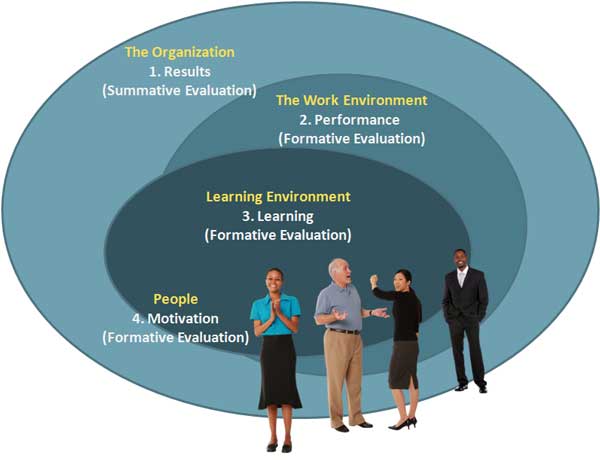I had an interesting discussion with Clark Quinn on using Kirkpatrick's model in learning processes other than courses. Clark argues that use of Kirkpatrick’s model is only for courses because training is the dominant discussion on their web site. I disagree and wonder if perhaps it is more of a “not invented here” hesitation because advancing concepts to the next level has often been a primary means of moving forward. It might sound good to forget an old model, but if you do not help people relearn, then their old concepts have a nasty habit of reappearing. In addition, training is far more than just courses. So after some heavy reflection I did a rewrite on my Kirkpatrick web page and have listed some of the highlights below.
More than Courses
While some mistakenly assume the four levels are only for training processes, the model can be used for other learning processes. For example, the Human Resource Development (HRD) profession is concerned with not only helping to develop formal learning, such as training, but other forms, such as informal learning, development, and education (Nadler, 1984). Their handbook, edited by one of the founders of HRD, Leonard Nadler, uses Kirkpatrick's four levels as one of their main evaluation models.
Kirkpatrick himself wrote, “These objectives [referring to his article] will be related to in-house classroom programs, one of the most common forms of training. Many of the principles and procedures applies to all kinds of training activities, such as performance review, participation in outside programs, programmed instruction, and the reading of selected books” (Craig, 1996, p294).
Kirkpatrick's levels work across various learning processes because they hit the four primary points in the learning/performance process... but he did get a few things wrong:
1. Motivation, Not Reaction
Reaction is not a good measurement as studies have shown. For example, a study shows a Century 21 trainer with some of the lowest reaction scores was responsible for the highest performance outcomes in post-training (Results) as measured by his graduates' productivity. This is not just an isolated incident—in study after study the evidence shows very little correlation between Reaction evaluations and how well people actually perform when they return to their job (Boehle, 2006).
When a learner goes through a learning process, such as an elearning course, informal learning episode, or using a job performance aid, the learner has to make a decision as to whether he or she will pay attention to it. If the goal or task is judged as important and doable, then the learner is normally motivated to engage in it (Markus, Ruvolo, 1990). However, if the task is presented as low-relevance or there is a low probability of success, then a negative effect is generated and motivation for task engagement is low. Thus it is more about motivation rather than reaction.
2. Performance, Not Behavior
As Gilbert noted, performance has two aspects: behavior being the means and its consequence being the end... and it is the consequence we are mostly concerned with.
3. Flipping it into a Better Model
The four levels are upside down as it places the two most important items last—results, and behavior, which basically imprints the importance of order in most people's head. Thus by flipping it upside down and adding the above two changes we get:
- Result - What impact (outcome or result) will improve our business?
- Performance - What do the employees have to perform in order to create the desired impact?
- Learning - What knowledge, skills, and resources do they need in order to perform? (courses or classrooms are the LAST answer, see Selecting the Instructional Setting)
- Motivation - What do they need to perceive in order to learn and perform? (Do they see a need for the desired performance?)
With a few further adjustments, it becomes both a planning and evaluation tool that can be used as a troubling-shooting heuristic (Chyung, 2008):

The revised model can now be used for planning (left column) and evaluation (right column).
In addition, it aids the troubling-shooting process. For example, if you know the performers learned their skills but do not use them in the work environment, then the two more likely troublesome areas become apparent as they are normally in the cell itself (in this example, the Performance cell) or the cell to the left of it:
- There is a process in the environment that constrains the performers from using their new skills, or
- the initial premise that the new skills would bring about the desired change is wrong.
The diagram below shows how the evaluation processes fit together:
Learning and Work Environment

As the diagram shows, the Results evaluation is of the most interest to the business leaders, while the other three evaluations (performance, learning, and motivation) are essential to the learning designers for planning, evaluating, and trouble-shooting various learning processes; of course the Results evaluation is also important to them as it gives them a goal for improving the business. For more information see Formative and Summative Evaluations.
I go into more detail on my web page on Kirkpatrick is you would like more information or full references.
What are your thoughts?
10 comments:
Very clever and enlightening revision of the application of the Kirkpatrick’s model. I´m really into this kind of analysis, revision and why not? extension and questioning of existing models and approaches . This is the way to improve our practices, I guess. It´s also a way to “practice what we preach”, since it´s not just about passively consuming information but also, creating new knowledge after critically revising that information. And, that´s what you have done here, through this article and the carefully though-out criticisms of the Kirkpatrick´s model , you´re suggesting a new well-validated perspective that we can definitely apply to the planning and evaluation phases of our ID process. Thanks for sharing your insights and experience with us!
Bingo! Thanks to taking the time to write and share your thoughts on this.
This is a really nice description of the changes to the updated Kirkpatrick Model, so thank you for that.
Just thought you might like to know that the TrainingCheck.com evaluation tool is based on this revised model, and it's free to use.
I like the work you have done on this.
My issue is not with the questions posed by Kirkpatrick or even that he posited the model in the era of training classes. Of course he did. He wrote it in ~1950. The questions that the model asks are good ones still. They are good, but not sufficient.
What I run up against when trying to use it with systems and workplace learning and support is the demand for a broader array of queries. You could call it a new kind of inquisitiveness which presses us to converge analysis and evaluation and to discover how findable resources are, how well the assets suit people at work, and how learning and development contribute to talent management.
I write about it in T&D, here: http://www.astd.org/TD/Archives/2010/Mar/1003_MetricsMatter.htm
Alas, it's not easy to get to because it is behind their firewall.
I fully agree with your argument that Kirkpatrick is not just for courses. I use it to evaluate elearning assets during my iterative development process. These assets are normally developed to support courses but they are not courses in themselves.
Basically what I do is once I delivered an Alpha version, I evaluate motivation (are learners interested by this type of tool?). The beta version is used to measure learning(how much do they learn from using this asset?). Finally, when the final version has been used for a while we assess on the job performance and results.
Because of the use I make of it, I however do not agree with you when you say they are upside down. For me they are in the right order because there is no point for me to measure performance if learners show no motivation nor learning.
I think in the end it's up to the instructional designer to adapt the tools to his process, not the other way around.
I think your point about the model's relevance to planning and evaluation is an important distinction. However, your revision misses the importance of the results for organizational goals.
In my opinion, the real significance of the Kirkpatrick Model is its relevance to how individual learning, whether based on formal training or informal/social learning, contributes to organizational learning and change management. You need an feedback arrow from results to organizational goals, otherwise levels 3 and 4 carry little meaning for an organizational model of performance that accounts for the contribution of individual learning outcomes. I articulated this point of view in an earlier blog post called Informal Learning, Collaboration, and the Kirkpatrick Model
Guy, as far as them being in the correct order, I believe there is no need to measure motivation or learning if they are performing correcting. Of course measuring all four levels will help the design team to make more precise adjustments, but the bottom line is that performance and results are still the key indicators of the success of the process.
Larry (Unknown), I agree with you that it would have been better if I had inserted an arrow to show the circular causality (casual loop) of the chart. I was thinking that the question in the Results cell, "Is the desired impact being felt?" was enough to show the casual loop.
Not sure how I ended up being "unknown" since I signed in with my Google account. I'm Larry Irons.
I understand your point Donald. I think Clark might in fact agree that using the model to analyze the relationship between learning and organizational performance makes sense. Perhaps I'm wrong on that.
Larry, I found your name when I looked at your post. Perhaps you need to update your Google or Blogger profile?
Post a Comment